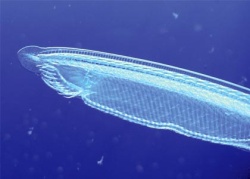25 July 2012
Evolutionary leap over 500 million years ago gives new insights into human diseases

Picture is of amphioxus.
An evolutionary leap made at the bottom of the ocean over 500 million years ago gives new insights into the causes of human diseases such as diabetes, cancer and neurological disorders, according to newly published research from scientists at the Universities of Dundee and St Andrews.
Vertebrates emerged around 500 million years ago from a massive evolutionary upheaval that involved two successive doublings in the amount of DNA in a marine invertebrate. These dramatic events triggered the evolution of a new animal, which became the ancestor of the backboned fishes, birds, reptiles and mammals, including humans.
"Amazingly, what happened so long ago still affects the life and diseases of modern humans," said Professor Carol MacKintosh, of the College of Life Sciences at the University of Dundee.
The new research, published in the Royal Society journal Open Biology, proposes how these ancient DNA doublings boosted internal communication systems. The result is that cells in our bodies are far better at integrating information than even the smartest smartphones.
Such complexity is needed to coordinate the actions of our elaborate human bodies. The downside is that communication breakdowns cause diabetes, cancer and neurological disorders.
Researchers have been able to compare the human genome to the recently decoded genetic sequence of the invertebrate amphioxus, a tiny creature still found in our seas and which can be regarded as a 'distant cousin' to our species.
"The ancestors of amphioxus did not go through the two rounds of genome duplication, so it is still quite similar to the original spineless creature," said Professor MacKintosh.
"You can still see the 'family resemblance' between amphioxus and humans, because like us, it has a nerve cord running down its back, blocks of muscle, and branchial arches where we have facial structures.
"However, unlike humans, amphioxus has no bones, no brain, no face and no heart. It is because of the two genome duplications that we gained the complexity to develop all these features.
"We study the complicated human systems that go wrong in diabetes and cancer. Now we will also look closely at this simpler animal to accelerate our understanding of human cells. We already have clues about important questions such as why did only certain genes survive the DNA doublings, how did they shape vertebrate evolution, and what is their impact on human health and diseases?"
Open Biology is the Royal Society's open access journal covering research in cellular and molecular aspects of biology. It is the Society's first wholly open access and online-only journal.
The paper will be available to read at http://rsob.royalsocietypublishing.org/ after the embargo is lifted.
For media enquiries contact:
Grant Hill
Press Officer
University of Dundee
Nethergate, Dundee, DD1 4HN
TEL: 01382 384768
E-MAIL: g.hill@dundee.ac.uk
MOBILE: 07854 953277 |

